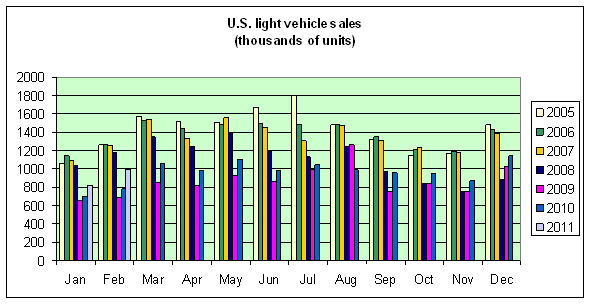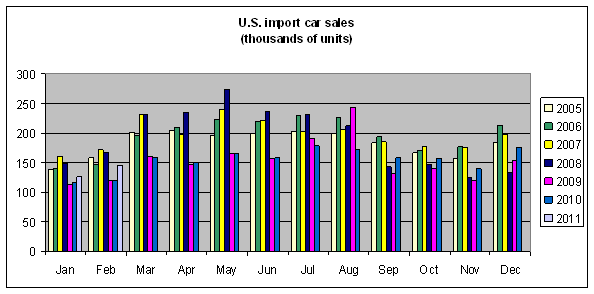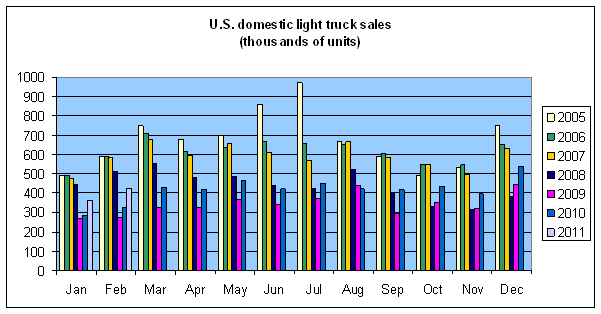The price of oil rose from $80 a barrel in September 2007 to average $134 in June 2008. The toll this took on the U.S. auto industry was in my mind an important factor that contributed to the first year of the Great Recession in 2007:Q4-2008:Q3. Given the recent concerns about oil supplies in North Africa and the Middle East, it’s useful to review what happened three years ago and relate it to where we stand at the moment based on the February auto sales data that were just released.
Americans bought 990,000 light vehicles in February. That’s up 27% from Feb 2010 and up 44% from Feb 2009. It’s still 21% below the February 2007 levels, but we’re finally more than half way back up.
 |
When oil prices were rising quickly in early 2008, sales of domestically-manufactured light trucks (which includes SUVs) plummeted, even as sales of more fuel-efficient imports were going up, as you can see from following the dark blue bars on the two charts below. As I noted in a paper presented at a Brookings Institution conference in 2009, in the absence of this hit to the domestic auto industry, U.S. real GDP would have grown by 1.2% over 2007:Q4-2008:Q3, a period now recognized as the first year of the Great Recession.
 |
 |
Looking at where we stand right now in 2011, domestic light truck sales have certainly been part of the rebound, and rising oil prices could easily take a bite out of that. But SUV sales are still far enough below even February 2008 values that it wouldn’t represent the same size hit to GDP as we experienced in the spring of 2008 even if light truck sales were to decline from here back to the levels of June 2008. On that basis, I conclude that the recent oil price run-up can’t cause the same dollar reduction in GDP today that we watched occur in 2008.
Moreover, I also want to read the latest auto sales figures in conjunction with the many other indicators we’ve been getting of a strengthening economy, such as continuing gains in disposable personal income and a
very strong ISM manufacturing report. Looks to me like the recovery continues to gain momentum. But I think March auto sales will be a critical indicator to be watching.
Interesting as always. You might want to take a look at trends in oil consumption. My rough data is picking up a pretty significant decline in US crude and products demand over the past three weeks, which I have had confirmed anecdotally. Maybe just a blip or a function of high inventories through the system, or maybe the prices have started to bite already.
I’m sorry, but I can’t feel anything but aggravation over increased sales of light trucks.
Buying light truck is a wasted money in coming gasoline price environment of 2011-2012. Either You do not drive the truck, or Your running costs for gasoline prevent You from buying other things/making investments that reduce costs.
Here is what oil prices most likely will look like , punctuated (and thus fluctuating) by spreading instability in supply nations.
http://saposjoint.net/Forum/download/file.php?id=2609
http://saposjoint.net/Forum/viewtopic.php?f=14&t=2626&start=0
We are currently at the first peak during the beginning of March. There are many more to come, driving the price of Brent up to 180 in extreme in May 2012, and that is not the final high, I just have not charted end of 2012 and 2013, when 200 USD barrel of Brent will be norm.
It’s great that in the narrow world of economics there is good news in the form of increased vehicle sales.
However, in the real world we inhabit, with the possibility of human induced climate change; wars for oil; burgeoning demand for harder to access new oil supply; a trillion dollar defense budget to protect oil, the only news about the car industry that would be good in the broader sense is documenting the rapid shift to high mileage vehicles and rapidly decreasing vehicle miles traveled. There’s no other good news to be found.
We need to start transitioning to using Natural gas to power our vehicles. Domestic and ona per BTU basis 1/4 the price of oil. Unless we cure our oil additicon, we will never solve the trade deficit problem, and it is more significant than the budget deficit, at least in the short to medium term (two or three years). I go into more detail here:
http://www.zacks.com/stock/news/48371/Cars%2C+Trucks%2C+Oil+and+Gas
A couple weeks ago I was in Detroit. Normally I go there 3 or 4 times a year, but in this case it had been about a year since I was last there. A year ago hotels were vacant, restaurants empty, strip malls boarded up, etc. I was surprised at how different things were compared to last year. Even the airport was crowded. So just to see if I was misreading things I looked at the BLS metropolitan data. A year ago the Detroit metro area had an unemployment rate of 14.9 percent. The latest numbers (Dec 2010) show unemployment has dropped to 11.1 percent.
For those lamenting the rise in sales of light trucks, until an alternative is found that fulfills the same function for tradesmen, expect every economic rise to be presaged by increases in their sales. And, that’s a very good thing!
You should shoot an email at me when you’re in Detroit sometime.
@ CoRev:
I think Ford has the right idea with the Transit Connect. They’re nice vehicles as long as you don’t have to tow or haul anything especially large/heavy. Until that particular problem is resolved light trucks are here to stay.
“But I think March auto sales will be a critical indicator to be watching.”
Just watch for the front page article showing some poor slob with his F-350 crying about gas prices. Similar to the family with 5 kids in front of their McMansion blathering about interest rates…
Stupid hurts.
Best jobless numbers we’ve seen in a while today.
Hi, I’m James Hamilton, I view car purchases as the primary goal of economic activity and therefore feel the need to constantly report on them. If people don’t spend as much on cars as they did in 2005, that means the economy is in failure, and therefore consumers need to take on more debt. That’s the only way I know how to think about the economy.
Silas Barta: Cute, but what I think I’m doing is objectively predicting what comes next rather than dictating what should be. To make an accurate prediction of what’s going to happen to GDP, I believe these numbers are relevant. And the reason I report them each month is that, to my knowledge, Econbrowser remains the only place on the web you can see these data displayed this way.
A couple of items on the internet:
Some exerpts from a presentation I made to House Energy Subcommittee staffers on Friday, the 18th:
http://ourfiniteworld.com/2011/03/03/steven-kopits-oil-the-economy-and-policy/
Also, John Kingston of Platts comments on a working paper of mine regarding the mobilization of the SPR. It’s a kind of follow-on from Jim Hamilton’s Brookings paper of 2009 on the same topic. John’s article is entitled: “Release oil from SPR? Here’s an even more aggressive suggestion”.
http://www.platts.com/weblog/oilblog/2011/02/27/release_oil_fro.html
The Saar results are predictable when you have govt. pushing the metal. The numbers are really a canard when you look at the fleet number and the subprime buyer getting bought again.
Its great our govt. can provide financing to subprime candidates that need to purchase a used vehicle. This will end badly.. The credit score destruction of the last 3 years demands subprime credit be loosened and thats exactly what is happening.
Its disgusting that we learn nothing from previous experience. I see abs credit inquiries daily in large numbers..
Mounting the charge with credit criminals as your leaders is sure suicide…something america does well in the FIRE industry..
Call me sick of it!
In the 2010 model year, the Chevy Tahoe is considered to be one of the best performing SUV that is out in the market. It is also very competitive in terms of fuel efficiency, able to get 22 mpg with the introduction of the new Tahoe Hybrid. The Tahoe’s competition in the big sport utility market are the Ford Expedition, the Nissan Armada, and the Toyota Sequoia in the gas-powered division; among the hybrids it takes on the Mercedes GL-class with its clean burning BlueTEC diesel engine, the BMW X6 Hybrid, and also GM’s own Cadillac Escalade Hybrid and Yukon Hybrid.
Such a world of difference between hally’s infomercial (what info wazzat again?) and cd’s up-to-the-moment vomit condition.
Well, I appreciate JDH’s bar graphs in all things…I need that linear approach and not be worried about fundamental holes in Induction (that would be adding several mpg to your worrisome quotient…no kidding).
Meanwhile I’m hoping for the intro of the Studebaker Siberia…not the retro you were thinking of but all new, no-compromisin Hybrid wuzzy, Hydrogen fuel powered, park your personal jet in the driveway.